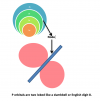Concentration in Chemistry-Mole Concept: Chemistry governs reactions and the ability of particles to interact with each other. It is an important concept in chemical equations, solutions, and more complex chemical processes. In this article, we’ll take a closer look at what concentration is and why it matters in chemistry.
What is Concentration in Chemistry?
Concentration in chemistry is a measure of the amount of a substance within a given volume. It’s usually expressed either in terms of moles per liter (M) or grams per liter (g/L). Concentration can be further divided into categories such as mass concentration, molarity, and molality depending on the type of substances being measured.
What are the Different Units of Concentration?
Concentration can be expressed in four different ways, including mass concentration, molarity, molality and normality. Mass concentration is expressed as the amount (volume) of a substance per a unit volume of solution. Molarity is expressed as the number of moles of a substance per liter of solution. Molality is the number of moles of solute per kilogram of solvent. Finally, normality is defined as the gram equivalent weight per liter.
How to Calculate Concentration Using Moles and Volume
To calculate concentration using moles and volume, you need to use the formula: Molarity (M) = number of moles (n) divided by volume (V). This can be expressed as n/V. For example, if you had 2 moles of sodium hydroxide in 1 Liter of solution, the calculation would be 2 moles / 1L = 2M.
How to Measure Concentration with Different Instruments
There are many instruments used to measure concentrations in solutions, such as spectrophotometers and refractometers. A spectrophotometer uses light to measure the concentration of a material contained in a solution, whereas a refractometer examines the amount of light bent when it passes through a solution. Refractometers are typically used when testing solutions that have very small concentrations because they require very little sample volume.
Common Applications of Concentration in Chemistry
Concentration is an important concept in chemistry, as it is used to describe the amount of material contained in a solution. Common applications of concentration in chemistry include measuring the solubility of a substance, calculating reaction rates, and determining mass percent composition. Additionally, concentrations are used to measure pH values and quantify the amount of reagents present in a given solution.
It is the amount(mass/volume) of a solute in a given amount(mass/volume) of a solution.
It can be expressed in many ways.
Mass by mass percentage = (Mass of solute/ Mass of solution)x100
Question: If 49 grams of Sulphuric acid are dissolved in 100 grams of a solutions, calculate the concentration of this solution?
Thus using the above formula,
Mass by mass percentage = (49 g/100g)x100
= 49%
Mass by volume percentage =(Mass of solute/ Volume of solution)x100
Question: If 50 grams of glucose are dissolved in 100 ml solution, calculate the concentration of the solution.
Thus Mass by volume percentage =(50g/ 100)x100
=50%
Volume by volume percentage =(Volume of solute/ Volume of solution)x100
If 20 ml of pure HCl acid are dissolved in 50 ml solution, calculate the concentration of the solution.
Thus Volume by volume percentage =(20 ml/ 50ml)x100
= 40%
PLEASE SHARE YOUR THOUGHTS ON Concentration in Chemistry-Mole Concept?
Want to learn the mole concept?

